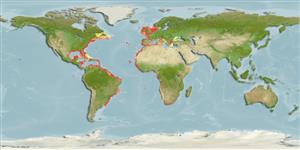Preferred temperature (Ref.
123201): 9 - 26.2, mean 17.8 °C (based on 1432 cells).
Phylogenetic diversity index (Ref.
82804): PD
50 = 0.5312 [Uniqueness, from 0.5 = low to 2.0 = high].
Bayesian length-weight: a=0.02188 (0.01871 - 0.02559), b=2.88 (2.83 - 2.93), in cm total length, based on LWR estimates for this species (Ref.
93245).
Nível Trófico (Ref.
69278): 4.1 ±0.2 se; based on diet studies.
Generation time: 4.0 (2.6 - 4.8) years. Estimated as median ln(3)/K based on 20
growth studies.
Resiliência (Ref.
120179): Médio, tempo mínimo de duplicação da população 1,4 - 4,4 anos (K=0.18-0.43; tm=1).
Prior r = 0.37, 95% CL = 0.25 - 0.56, Based on 1 full stock assessment.
Fishing Vulnerability (Ref.
59153): Moderate to high vulnerability (46 of 100).
🛈
Climate Vulnerability (Ref.
125649): Low to moderate vulnerability (32 of 100).
🛈
Nutrients (Ref.
124155): Calcium = 17.4 [6.5, 68.9] mg/100g; Iron = 0.507 [0.242, 1.275] mg/100g; Protein = 19.7 [18.6, 20.8] %; Omega3 = 0.212 [0.146, 0.316] g/100g; Selenium = 21.2 [8.9, 47.8] μg/100g; VitaminA = 25 [6, 111] μg/100g; Zinc = 0.5 [0.3, 0.8] mg/100g (wet weight); based on
nutrient studies. 